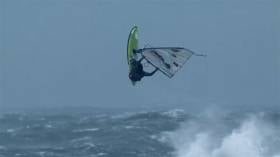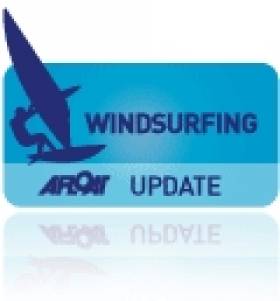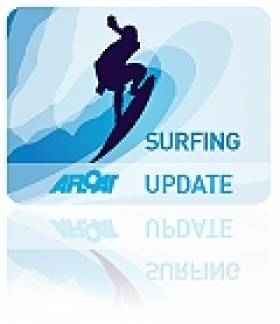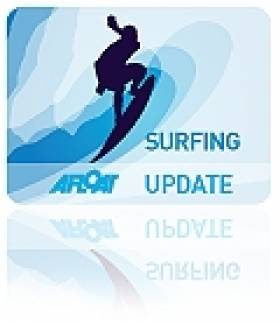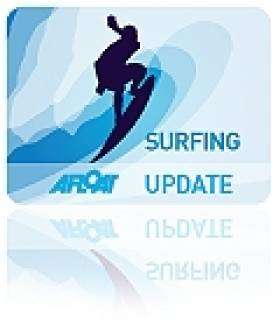Displaying items by tag: Red Bull Storm Chase
Force 10 winds forecast for this weekend will attract eight of the world’s more fearless windsurfers to Ireland’s Atlantic coast for a competition three years in the making.
As BreakingNews.ie reports, the precise date and venue for the Red Bull Storm Chase along the Wild Atlantic Way have not yet been decided, being influenced by where the squalls currently tracking towards Ireland ahead of two major storm systems will make landfall.
But if conditions prove optimal, the brave boarders will take to the big waves — judged on the size of their high-flying jumps, their artistry in the air and their overall style amid winds in excess of 100kmh.
BreakingNews.ie has more on the story HERE.
Storm Chase Mission 2 Abandoned At Last Minute
#Windsurfing - Mission 2 of the Red Bull Storm Chase to Galicia has been abandoned at the last minute due to an unstable weather forecast for the coast of northern Spain.
It's a big blow to the six waveriders who qualified for the second-stage of the global windsurfing challenge after three rounds of exciting competition in Brandon Bay less than two months ago.
The storm-force winds that swept the Kerry coast at the end of January provided the perfect conditions to test the mettle of the brave sailboarders who took to the water at the 'Dumps' ad 'Hell's Gate'.
Of the ten-strong field, six survived to advance to the second round - Marcilio Browne, Dany Bruch, Victor Fernandez, Robby Swift, Julien Taboulet and Thomas Traversa.
And Red Bull have posted a video compilation of highlights of all the action from Mission 1 in Kerry, which you can see below:
Red Bull Storm Chasers Take off in Kerry
#redbull – The organisers of Red Bull Storm Chasers have scrambled all their crews and teams who had 48hrs to travel from across the globe to Ireland for the first "Mission" on the 3 mission challenge writes Brian Carlin.
Today saw the majority of the country hit with storm force winds. It's results included debris filled roads, heavy traffic, structural damage to buildings and generally unwanted among the most of the country.
Well, not quite the same could be said if you were standing on the back beach in Castlegregory, Co.Kerry locally known as "Dumps" this morning.
It's simple, Red Bull Storm Chase set a 4 month challenge where they require 3 "missions" to be completed. There is 7 possible locations, United States, Iceland, Ireland, Spain, France, Tasmania and Japan.
The conditions seemed just right for the organisers who pulled the trigger Saturday, a logistically nightmare to get the gear, teams, TV crews, helicopters to Ireland.
The first session of the day kicked off in Dumps, Co.Kerry at 7am. A dark morning that quickly brightened by mid-morning. There was a small gathering, massively understated as I read the event is "Windsurfing's Most Challenging Contest". It wasn't long before I understood the attitude, these guys were interested in the sport, they didn't care about hitting news headlines or making the papers, they spoke and were friendly but it was obvious the feeling was focused on the event and nothing else. Serious dedication. In fact I spoke with a competitor who told me his opposition flew in from Maui at 1.30am Monday to Dublin airport. He jumped straight into a car drove through the night. Had his breakfast and showered, then proceeded to suit up for the days challenge.
The crowds did begin to grow and by 12pm about 100 spectators looked on. The winds increased with gusts recorded over 50 knots. As the wind slightly shifted from south west to west south west the organisers decided to move the camp and head to "Hell's Gate". You couldn't build what seemed to be the God's natural Amphitheatre for this event. A little rocky cove that backed onto the North Atlantic, slightly sheltered which made launch and recovery much easier. The cliffs were lined with a variety of young and old, even the local farmers stopped traffic in their tractors to what must have been a rather unusual sight, Red Bull cars and vans, a low flying helicopter and handful of windsurfers who seemed to spend as much time in the air as in the water.
Six sailors now advance to the next mission, where and when? only the weather can decide the time and date.
Windsurfers Race to Kerry for Red Bull Storm Chase
#Windsurfing - Due to 2012's calm storm season, organisers of the Red Bull Storm Chase recently extended the competition into this year - and competitors are currently racing to Ireland for the first mission of the contest.
Brandon Bay in Kerry was decided as the spot early this morning, and the competition is scheduled to begin just after sunrise tomorrow (Monday 28 January) when stormy weather conditions are expected to be at their peak.
The Red Bull Storm Chase website has live updates from competitors making their way to Kerry from as far away as the Marshall Islands in the Pacific Ocean.
Ten windsurfers chosen by community vote will take part in the first mission, with the top six going on to the second mission some time before 22 March at any one of seven possible destinations around the world, most of which have not before taken centre stage on the windsurfing scene.
Sadly no Irish windsurfers will be competing this time round, but names the likes of Timo Mullen and Dan Gardner on the shortlist will surely be keeping an eye on the competition as they get set to chase the ride of their lives.
#WINDSURFING - Ireland's windsurfers have been set with the challenge - find the strongest storm conditions for the ride of their lives.
The Red Bull Storm Chase 2012 will see 10 of the world’s best windsurfers take part in what the energy drinks brand describes as the most challenging windsurfing contest of all time, as they sail willingly into force 10 winds and monster surf to match.
Suggestions for venues opened on 1 May at redbullstormchase.com - and no doubt the incredible storm surges off Mullaghmore Head will be at the top of Irish lists.
Come July, amateurs and professionals alike from around can register to take part, with a community vote deciding the 10 finalists. Then from August to November, the global hunt for the storms begins, with the field gradually narrowing down to determine the victor.
"Red Bull Storm Chase gives us a dream contest," said PWA World Tour head judge head judge Duncan Coombs. "We’ll travel to the storm instead of waiting for it to find us. We can expect to pull off a competition in the most extreme wind and wave conditions, in new found places.
"We will do our best to push the boundaries of competition and to explore the world’s most radical conditions."


























